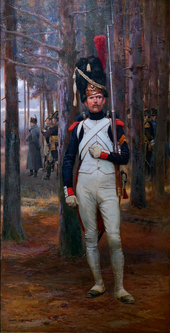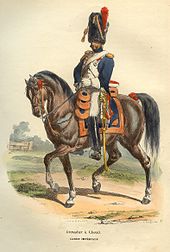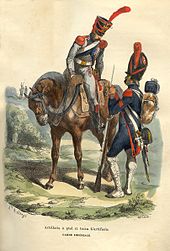Guard impériale
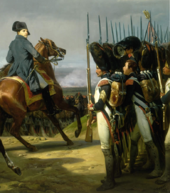
The Imperial Guard ( French Garde impériale ) came into being in France in 1804 after Emperor Napoleon ascended the throne by renaming the "Consular Guard".
Napoleon and his guard
The Imperial Guard, built up in 1804 on the basis of the old consular guard, was a personal creation of Napoleon. At the beginning it consisted of only eight units:
- the regiment grenadiers à cheval de la Garde impériale
- the Régiment Chasseurs à cheval de la Garde impériale
- the Mamelouks de la Garde impériale
- the regiment of the Gendarmerie d'élite de la Garde impériale
- the one he régiment de grenadiers à pied de la Garde impériale
- the one he régiment de chasseurs à pied de la Garde impériale
- the battalion des Marins de la Garde impériale
- the Régiment d'artillerie à cheval de la Garde impériale
In the following 11 years of the Guard's existence, a large number of formations were added, such as the Régiment de dragons de la Garde impériale 1806, the 1 er régiment de chevau-légers lanciers polonais de la Garde impériale 1807 or the Compagnie de Sapeurs de la Guard impériale 1810.
When planning the Russian campaign , it comprised almost 52,000 men. The emperor alone checked and controlled the recruiting, promotions and took care of all further details of the service up to the appearance of the uniforms . Over the course of his numerous campaigns and battles, Napoleon developed a very personal relationship with the Guard , which not only guaranteed his personal safety during war, but was also used in peacetime for representation purposes - for example through their presence at state banquets. Napoleon knew several hundred of his guards soldiers by name and also took care of individual fates, which reinforced the close personal bond between him and the soldiers. Until Waterloo, it was considered almost invincible.
Privileges
Members of the Guards Infantry received twice as high pay as soldiers of the simple line regiments . A Guard Grenadier, for example, received 80 centimes a day, while his counterpart in the line earned 30 centimes a day. The guards ranks each ranked one rank above those of the regular army, i. H. the sergent major ( staff sergeant ) of the guard was of the same rank as the sous-lieutenant of the line, the guard lieutenant ranked with the captain of the line. The guard units were better catered for and each soldier had his own soup bowl, while all the other soldiers of the Grande Armée had to eat several from one pot. In addition, the Guard had its own hospital in Gros-Caillou near Paris , which was under the direction of the famous military doctor Dominique Jean Larrey and whose medical staff was selected with great care. If a guards regiment encountered a simple line regiment on its march, the latter was obliged to clear the way for the guards, to stop and present their weapons. All of these privileges were designed to create a sense of pride among the members of the Guard and thus to increase the soldiers' motivation.
Outline, strength
The Guard of the Empire comprised all arms of the time. It consisted of heavy infantry ( grenadiers ), light infantry ( hunting , Voltigeurs , skirmishers , and later Flanquere) heavy and light cavalry , foot artillery , of mounted artillery , gendarmes , marines and pioneers . The Imperial Guard was divided into the "Old", the "Middle Guard" and the "Young" Guard. The 3rd and 4th grenadiers and the 3rd and 4th hunters, like the fusilier grenadiers and the fusilier hunters, were referred to as the "Middle Guard".
After special achievements on the battlefield, individual regiments were raised to guard regiments: After the loss-making victory at the Somosierra Pass in Spain (November 30, 1808), the Polish Chevaulegers were transferred from the “Young Guard” to the “ Old Guard ”. The eyewitness Philippe-Paul de Ségur reported that the bravery of the regiment so impressed Napoleon that he let it skip the "Middle Guard".
The following snapshot from the day of the Battle of Ligny (June 16, 1815) gives an approximate overview of the organizational structure and troop strength towards the end of the First Empire:
| The Imperial Guard ( La Garde Impériale ) | |||
| Aide major général | Marshal Adolphe Mortier , General de division Comte Drouot from June 18 | ||
| Commander of the artillery and marines | General de division Baron Desvaux de Saint Maurice | ||
| Commandant du génie | General de division Baron Haxo | ||
| Old guard | |||
| 1st division | General de division Comte Friant | ||
| Grenadier Brigade on foot | General de division Comte Rouget | ||
| 1. Grenadiers on foot | General de brigade Baron Petit | (2 battalions) | 1,006 men |
| 2. Grenadiers on foot | Baron Christiani | (2 battalions) | 1,063 men |
| 3. Grenadiers on foot | Morvan | (2 battalions) | 1,146 men |
| 4. Grenadiers on foot | General de brigade Harlet | (1 battalion) | 503 men |
| 2nd division | General de division Comte Morand | ||
| Chasseur Brigade on foot | General de division Comte Michel | ||
| 1. Hunter on foot | Colonel Comte Cambronne | (2 battalions) | 1,271 men |
| 2. Hunter on foot | General de brigade Baron Pelet | (2 battalions) | 1,031 men |
| 3. Hunters on foot | Chevalier Malet | (2 battalions) | 1,028 men |
| 4. Hunters on foot | Henrion | (2 battalions) | 1,041 men |
| Young Guard General de division Comte Duhesme | |||
| 1st brigade | Chart edge | ||
| 1. Voltigeurs | Malcolm | (2 battalions) | 1,188 men |
| 1. Screechers | Secretan | (2 battalions) | 935 men |
| 2nd brigade | Guye | ||
| 3. Voltigeurs | Pailhes | (2 battalions) | 1,271 men |
| 3. Screechers | Hurel | (2 battalions) | 1,031 men |
| Light cavalry | General de division Comte Lefebvre-Desnouettes | ||
| Chasseurs à cheval | General de division Baron Lallemand | (7 escadrons) | 1,197 men |
| 1st regiment de chevau-légers lanciers de la Garde impériale | Colonel Pawel Jerzmanowski | ||
| 2 e régiment de chevau-légers lanciers | General de Colbert-Chabanais division | (6 escadrons) | 880 men |
| Lanciers lituaniens de la Garde impériale | Colonel Jan Konopka | ||
| Tartares lituania | Samuel Murza Ulan | ||
| 1 he regiment des éclaireurs | Colonel Claude Testot-Ferry | ||
| 2 e regiment des éclaireurs | Colonel Laurent Hoffmayer | ||
| 3 e regiment éclaireurs | Colonel Jan Leon Kozietulski | ||
| Heavy cavalry | General de division Baron Guyot | ||
| Grenadiers à cheval | Dubois | (6 escadrons) | 796 men |
| dragoon | Major Laurent Hoffmayer (last) | (6 escadrons) | 880 men |
| Foot artillery | General de brigade Henri Dominique Lallemand | (72 cannons) | 702 men |
| Artillery on horseback | Duchand | (24 cannons) | 380 men |
- Illustration of the Guard Infantry Regiments by Adolphe de Chesnel
- Illustration of the Guard Cavalry Regiments by Adolphe de Chesnel
Use of the guard
Napoleon often used the guard as a last reserve in his battles and preferred to deploy them in decisive battle situations. In particular, he was happy to delay the use of the Old Guard as long as possible. As a result, in some battles (e.g. at Austerlitz) the Old Guard remained largely inactive.
In contrast, the Young Guard - which in the campaign of 1813 had grown to 19 regiments of voltigeurs and tirailleurs - was deployed relatively often alongside the line troops.
Myths and Legends
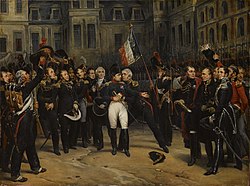
Often only the so-called "Old Guard" wearing bearskin hats is depicted on the 19th century history painting . The mounted grenadiers were somewhat contemptuously called "the immortals" by the troops of the line, as they were not normally used in combat, but "only" to cover the imperial headquarters.
The grenadier regiments of the "Old Guard" with the high bearskin hats were reverently and respectfully referred to as "gods" by their opponents, as they made an impressive figure on the battlefield due to their increased size. The idea that the Guard were all well-equipped soldiers does not stand up to contemporary evidence. For example, the British artist Benjamin Haydon wrote after his visit to Fontainebleau Palace in 1814:
“More dreadful looking fellows than Napoleon's Guard I have never seen. They had the look of thoroughbred, veteran, disciplined banditti. Depravity, recklessness, and bloodthirstiness were burned into their faces […] Black mustachios, gigantic bearskins, and a ferocious expression were their characteristics. "
“I have never seen soldiers look more horrific than those of the Napoleonic Guard. They looked like well-bred, battle-hardened, disciplined muggers. Depravity, ruthlessness and thirst for blood were burned into their faces [...] Black mustaches, huge bearskins [bearskin hats] and a grim facial expression made their appearance. "
Even if Haydon's judgment of the soldiers described was not free of prejudice and his description served the expectations of his English compatriots, other sources also show that in the spring of 1814 the guards regiments, some of which were only provisionally equipped, did not correspond to the image that was later of them was painted. However, this also applied to many other armies of the time.
In France, the soldiers of the "Old Guard" were referred to as " grognards " (German: "Brummbären").
At the Battle of Waterloo , the Imperial Guard was also drawn into the general overall defeat. After a last loss-making attack, she found herself in an untenable position and was asked to surrender. Her commanding General Pierre Cambronne was ascribed the quote " la vieille garde meurt, mais elle ne se rend pas " (German: "The (old) guard dies, but they do not surrender") ( winged words ).
Overview of the entire inventory of the guard
infantry
Vieille Garde (Old Guard)
This consisted of long-serving veterans who claimed to be the most deserving soldiers in French military history.
- 1 er régiment de grenadiers à pied de la Garde impériale (established 1799)
- 1 er régiment de chasseurs à pied de la Garde impériale (established in 1800)
Moyenne Guard (Middle Guard)
- Grenadiers (Grenadiers)
When the Middle Guard was set up in 1804, the grenadiers consisted of a regiment of two battalions with 1,620 men, and a Veliten battalion of 950 men. In 1806 a second regiment of grenadiers was established. The two regiments were merged as early as 1808. In 1810, after the annexation of the Kingdom of Holland , the existing Royal Guard Grenadier Regiment was incorporated into the Middle Guard as the new 2nd Grenadier Regiment on foot.
In 1815 there were four regiments of grenadiers on foot in the middle guard:
- 2 e régiment de grenadiers à pied de la Garde impériale (1806–1809 and 1811–1815)
- 2 e régiment de grenadiers à pied (hollandais) (from 1810)
- Bataillon de grenadiers polonais (Polish Grenadier Battalion - established in 1812)
- 3 e régiment de grenadiers à pied de la Garde impériale (established 1811)
- 4 e régiment de grenadiers à pied de la Garde impériale (established 1815)
- Chasseurs à pied (hunters on foot)
The chasseurs à pied of the guard were set up at the same time as the grenadiers. In theory, they were recruited from the light infantry, while the grenadiers complemented each other from the line infantry.
- 2 e régiment de chasseurs à pied de la Garde impériale
- 3 e régiment de chasseurs à pied de la Garde impériale (established 1815)
- 4 e régiment de chasseurs à pied de la Garde impériale (established 1815)
- Fusiliers (fusiliers)
- Régiment of fusiliers-Chasseurs de la Garde impériale (1 he régiment de fusiliers de la Garde impériale - established 1806)
- Régiment des fusiliers-grenadiers de la Garde impériale (2 e régiment de fusiliers de la Garde impériale - established 1806)
Jeune Garde (Young Guard)
- 1 he régiment de tirailleurs de la Garde impériale (established 1809–1810)
- 2nd régiment de tirailleurs de la Garde impériale (established 1809–1810)
- 3e régiment de tirailleurs de la Garde impériale (established 1809–1810)
- 4th régiment de tirailleurs de la Garde impériale (established 1809–1810)
- 1st regiment de voltigeurs de la Garde impériale (established 1809–1810)
- 2nd régiment de voltigeurs de la Garde impériale (established 1809–1810)
- 3e régiment de voltigeurs de la Garde impériale (established 1809–1810)
- 4th régiment de voltigeurs de la Garde impériale (established 1809–1810)
- Régiment de flanqueurs-chasseurs de la Garde impériale (established in 1811)
- Regiment de flanqueurs-grenadiers de la Garde impériale (established in 1813)
- Tirailleurs (shooters)
- 5 e régiment de tirailleurs de la Garde impériale (established in 1811)
- 6 e régiment de tirailleurs de la Garde impériale (established in 1811)
- 7 e régiment de tirailleurs de la Garde impériale (established in 1813)
- 8 e régiment de tirailleurs de la Garde impériale (established in 1813)
- 9 e régiment de tirailleurs de la Garde impériale (established in 1813)
- 10 e régiment de tirailleurs de la Garde impériale (established in 1813)
- 11 e régiment de tirailleurs de la Garde impériale (established in 1813)
- 12 e régiment de tirailleurs de la Garde impériale (established in 1813)
- 13 e régiment de tirailleurs de la Garde impériale (established 1813)
- 14 e régiment de tirailleurs de la Garde impériale (established 1814)
- 15 e régiment de tirailleurs de la Garde impériale (established 1814)
- 16 e régiment de tirailleurs de la Garde impériale (established in 1814)
- Voltigeurs
- 5 e régiment de voltigeurs de la Garde impériale (established in 1811)
- 6 e régiment de voltigeurs de la Garde impériale (established in 1811)
- 7 e régiment de voltigeurs de la Garde impériale (established 1813)
- 8 e régiment de voltigeurs de la Garde impériale (established in 1813)
- 9 e régiment de voltigeurs de la Garde impériale (established in 1813)
- 10 e régiment de voltigeurs de la Garde impériale (established in 1813)
- 11 e régiment de voltigeurs de la Garde impériale (established in 1813)
- 12 e régiment de voltigeurs de la Garde impériale (established in 1813)
- 13 e régiment de voltigeurs de la Garde impériale (established in 1813)
- 14 e régiment de voltigeurs de la Garde impériale (established in 1814)
- 15 e régiment de voltigeurs de la Garde impériale (established 1814)
- 16 e régiment de voltigeurs de la Garde impériale (established in 1814)
- Dragons à pied (Dragoons on foot)
Mounted units in companies were converted into dragoons on foot three times. They were assigned to the grenadiers of the guard, but without belonging to them. Their existence was short-lived each time, however, and they were soon made mounted again.
- 1 he regiment de dragons à pied
- 2 e régiment de dragons à pied
Other corps
- Pupilles de la Garde
The Régiment des Pupilles de la Garde was formed in 1811 from the royal Dutch Veliten (sons of fallen soldiers). The regiment consisted of nine battalions, but was reduced to two battalions in 1813, since the others had been transferred to the units of the Tirailleurs and Voltigeurs of the Young Guard.
- Vélites de Turin et de Florence (Velites of Turin and Florence)
There was one battalion each, formed in 1809. Organization and uniforms were similar to the Fusiliers de la Garde .
- Petite garde (Little Guard)
The petite garde was assigned to the king of Rome .
cavalry
- 1804
existed three units
- the Grenadiers à cheval de la Garde impériale (Vieille Garde).
- the Chasseurs à cheval de la Garde impériale (Vieille Garde) - including the subordinate Mamelouks de la Garde impériale
- two escadrons of the gendarmes d'élite
- 1806
- the Dragons de la Garde impériale were set up.
- 1807
After the invasion of Poland, Napoléon ordered the establishment of the Régiment Lanciers polonais de la Garde impériale , which was formed from Polish nobles. However, they did not receive the lance until after the Battle of Wagram in 1809.
- 1808
The regiment Chevau-légers de Berg was attached to the Guard, then dissolved in 1809, the riders transferred to the Chasseurs à cheval (Vieille Garde) .
- 1809
The Regiment Chasseurs à cheval de Berg received the lance and was assigned to the Guard.
- 1810
The 2nd e régiment de chevau-légers lanciers de la Garde impériale (called "lanciers rouges") was formed from the regiment of the Dutch guard hussars.
- 1812
At the beginning of the Russian campaign , the guard cavalry had reached its highest personnel level.
The regiments of the Grenadiers à cheval , the Chasseurs à cheval , the Dragons and the Polish Chevau-légers lanciers each consisted of five escadrons. A 3rd regiment of the Chevau-légers lanciers was set up, but it had been destroyed before the end of the campaign.
Theoretically, every regiment of the Chevau-légers lanciers should be equipped with a 120 rider strong Escadron Tartares lituaniens (Lithuanian Tartars), but there was only one such escadron in the 3rd regiment.
- Back from Russia
The guard cavalry was almost completely destroyed in Russia, but they were then set up again. In addition, the three regiments Éclaireurs de la Garde impériale , which were equipped with the lance and whose 1st regiment was assigned to the Grenadiers à cheval , the 2nd to the Dragons and the 3rd to the Chevau-légers lanciers , were reorganized . The first two regiments were French, the 3rd regiment was recruited from Poles.
- 1813
In that year, four regiments of the Gardes d'honneur were set up , consisting of members of the sons of the nobility and the upper class from France, Belgium, Holland and Italy. Napoléon relied on the young people who had previously been spared confiscation. You should join this guard formation and equip yourself at your own expense.
- Chasseurs à cheval (Vieille Garde)
The regiment consisted of four escadrons.
- Mamelouks de la Garde impériale

- (Established 1813), successor unit of a company established in 1804. Assigned to the regiment des chasseurs à cheval .
Grenadiers à cheval (Vieille Garde)
The regiment consisted of four escadrons.
Régiment de dragons de la Garde impériale (Dragoons)
- (called Dragons de l'Impératrice )
Chevau-légers lanciers

- 1 he régiment de chevau-légers polonais de la Garde impériale (established 1807). After being equipped with the lance, it was renamed Chevau-légers lanciers polonais in 1809
- 2 e régiment de chevau-légers lanciers de la Garde impériale (called Lanciers rouges - Red Uhlans ), established in 1810 from the Dutch guard hussars. Consisting of 8 battalions and, from 1813, with a company of the Municipal Guard of Paris . The first four (Dutch) battalions belonged to the Old Guard, the other four (French) battalions belonged to the Young Guard.
- 3 e régiment de chevau-légers lanciers de la Garde impériale (established and destroyed in 1812)
Gendarmerie d'élite (elite gendarmerie)
There were two companies:
- Gendarmerie d'élite de la Garde impériale
- Gendarmerie d'ordonnance de la Garde impériale
Gardes d'honneur (Honor Guard)
- 1 he regiment de gardes d'honneur de la Garde impériale
- 2 e régiment de gardes d'honneur de la Garde impériale
- 3 e régiment de gardes d'honneur de la Garde impériale
- 4 e régiment de gardes d'honneur de la Garde impériale
Éclaireurs (scouts of the guard)
The 1st regiment belonged to the Old Guard.
- 1 he regiment des éclaireurs de la Garde impériale
- 2 e régiment des éclaireurs de la Garde impériale
- 3 e régiment des éclaireurs de la Garde impériale
All regiments were formed on December 9, 1813.
Other units
- Chevau-légers du Grand-duché de Berg
- Tartares lituaniens de la Garde impériale (an escadron erected in 1812)
artillery
Artillerie à cheval (mounted artillery)
Originally a single company of mounted artillery existed in the Guard in 1804. In 1806 it was increased to a regiment. It was equipped with 6-pounder cannons, the majority of which consisted of booty.
- Régiment d'artillerie à cheval de la Garde impériale
Artillerie à pied (foot artillery)
In 1808 the "Regiment d'artillerie à pied de la Garde" was set up. It carried 12-pounder guns. A second regiment was established in 1812.
- 1 he régiment d'artillerie à pied de la Garde impériale
- 2 e régiment d'artillerie à pied de la Garde impériale
Train d'artillerie (artillery train)
The artillery became a weapon that became more and more important over time. This also had an effect on the train as a supplier of the artillery. It became more and more extensive until the end of the empire.
In 1806 it consisted of one battalion, in 1809 of two battalions. In February 1810 a regiment of three battalions was established, which was followed by a second regiment in April. During the reign of the Hundred Days, the artillery train still consisted of nine companies, one of which was assigned to the Young Guards.
- 1 he regiment du train d'artillerie de la Garde impériale
- 2 e regiment du train d'artillerie de la Garde impériale
Navy (Marine Infantry)
Established in September 1803, the unit of the "Marins de la Garde impériale" was assigned to the Old Guard. It was a battalion that was divided into five "Equipages". Most of the battalion was destroyed in 1808 in the Battle of Bailén . In 1809 there was therefore only one "Equipage". In September 1810, the battalion was brought back to eight "Equipages". In 1815, in the Guard of the Rule of the Hundred Days, there was only one "Equipage" of 150 men. The battalion de marins de la Garde impériale was often subordinate to the artillery.
Génie (pioneers)
In 1813 the guards pioneers consisted of 275, and finally 400 men who were assigned to the Young Guard. In January 1814, the Genié de la Garde was combined into a battalion of four companies. The 1st Company belonged to the Old Guard. The uniform of the line pioneers was worn in the campaigns.
After the major fire in the Austrian Embassy in Paris in 1810, the Sapeurs de la Garde impériale were set up with 140 men. They were supposed to serve as a fire brigade for the imperial palaces.
Other services
- Battalion d'instruction de Fontainebleau
Training battalion in Fontainebleau - established in 1812 for the training of NCOs of the Young Guard.
- Pontonniers
A swimming bridge company was assigned to the Guards foot artillery regiment for the Russian campaign . The company distinguished itself in the battle of the Berezina .
- medical corps
The Guard's medical service was entrusted to capable men such as Dominique Jean Larrey , Pierre-François Percy and René-Nicolas Dufriche Desgenettes , but they were poorly equipped. For this reason, in the face of serious injuries, amputation was often the only option - also because there was no way of providing adequate quality care.
literature
- Oleg Sokolov: L'Armée de Napoléon. Editions Commios, 2005, ISBN 978-2951836419 - with a foreword by Jean Tulard.
- Émile Marco de Saint-Hilaire: Histoire anecdotique, politique et militaire de la Garde impériale. Editeur E. Penaud, Paris 1847.
- Henry Lachouque: Waterloo 1815. Editions Stock, 1972.
- Yves Martin: Les Aigles en Espagne - La garde de Paris. Tradition Magazine numéro 275, September / October 2014, pp. 14–17.
- Jean-Claude Lorblanchès: Les soldiers de Napoléon en Espagne et au Portugal 1807-1814. éditeur L'Harmattan, 2007, ISBN 978-2-296-16464-2 .
- Alain Pigeard: La Conscription au temps de Napoléon 1798-1814. Editeur Bernard Giovanangeli, 2003, ISBN 978-2-909034-45-4 .
- Georges Blond: La Grande Armée. Laffont, Paris 1979, ISBN 2-221-50078-4 .
- Alain Pigeard: Dictionnaire de la Grande Armée. Tallandier, Paris 2002, ISBN 2-84734-009-2 .
- Jean Tranié: Guard impériale. In: Jean Tulard (ed.): Dictionnaire Napoléon. New edition Fayard, Paris 1995, ISBN 2-213-02286-0 , pp. 775-777.
- Henri Lachouque: Napoléon et la Garde impériale. Bloud & Gay, Paris 1957.
- English translation: The anatomy of glory. Napoleon and his guard. A study in leadership. 4th ed. Greenhill Books, London 1997, ISBN 1-85367-264-5 (with a new introduction by John R. Elting).
- G. Charmy: Splendeur des Uniformes de Napoléon. Hérissey, Evreux 2003.
- Volume 2: La Garde impériale à pied . ISBN 2-914417-09-8 .
- Volume 3: La Garde Impériale à cheval . ISBN 2-914417-10-1 .
Web links
Footnotes
- ↑ see: Segur's eyewitness account
- ↑ or recruits from areas claimed by French
- ↑ for whatever reason
